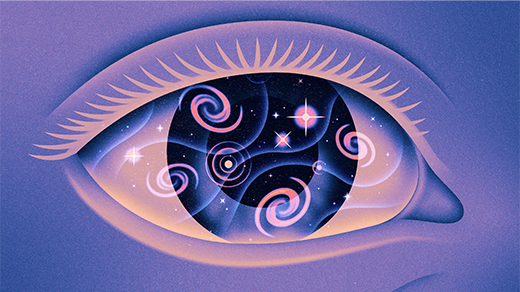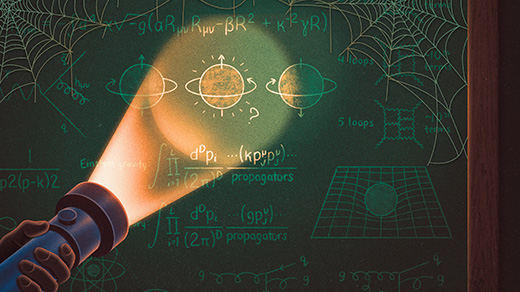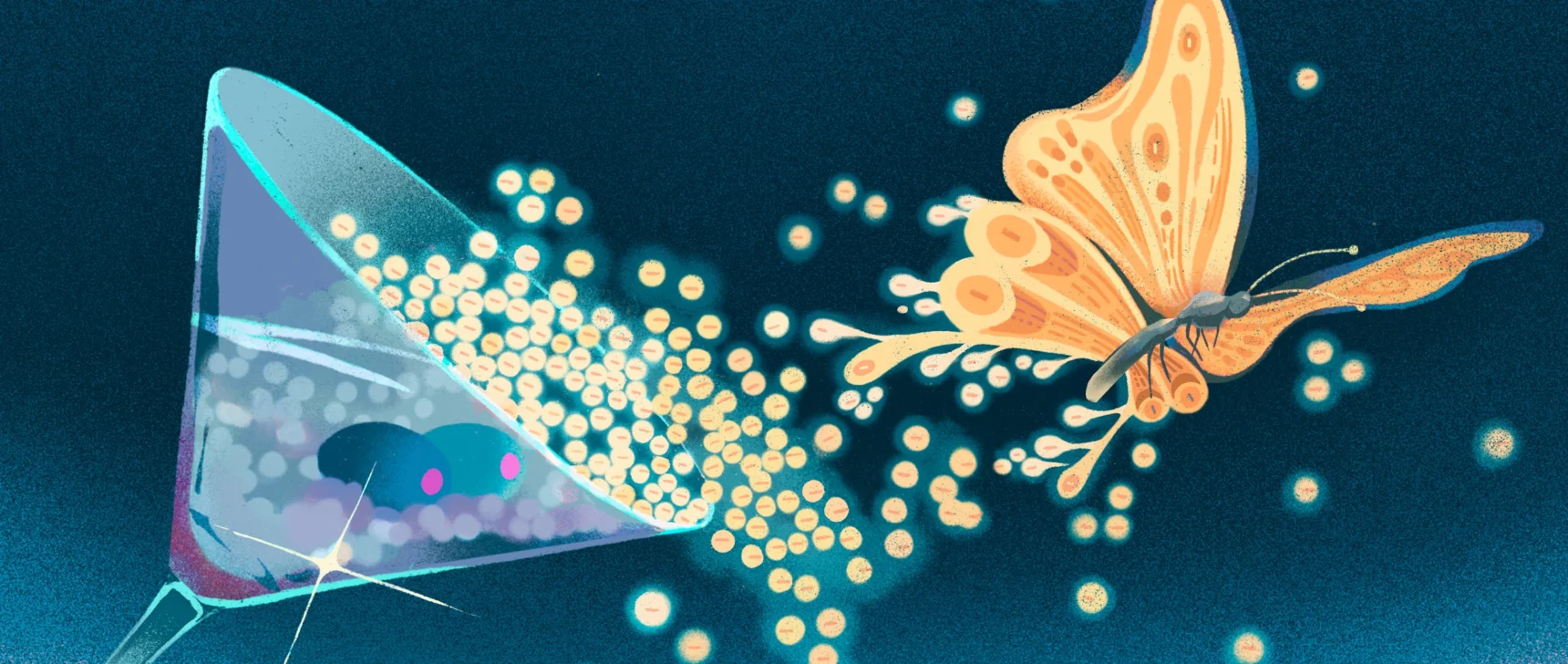Astrophysicists Find No ‘Hair’ on Black Holes
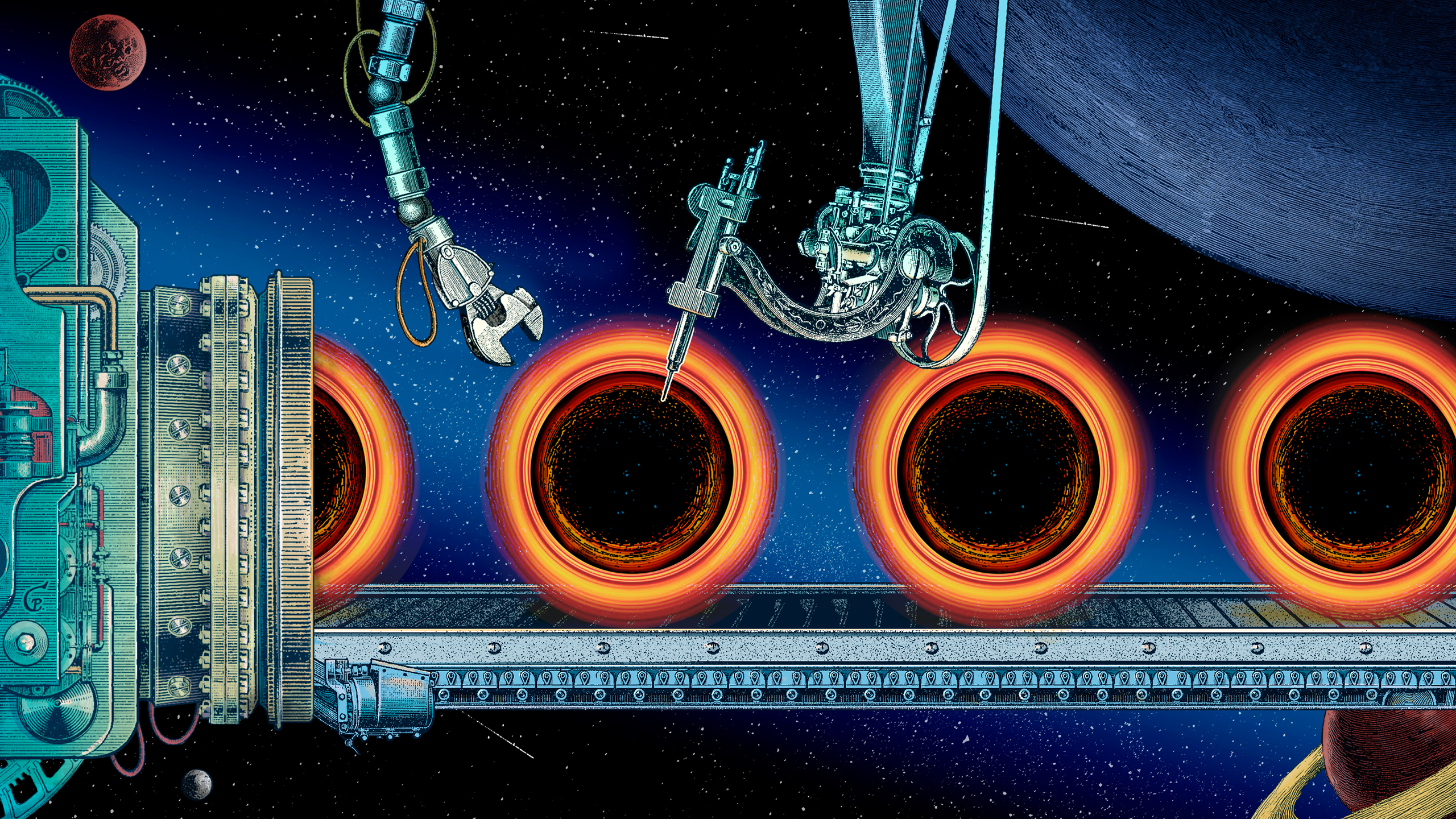
Do black holes have a cookie-cutter form, or subtle distinctions that reveal each one’s unique history and makeup?
Celsius Pictor for Quanta Magazine
Introduction
According to Albert Einstein’s general theory of relativity, the behavior of a black hole depends on two numbers: how heavy it is, and how fast it is rotating. And that’s it. Black holes are said to have “no hair” — no features that distinguish them from their fellows with the same mass and spin.
With new data, it has started to become possible to test this no-hair conjecture. Astronomers have detected hundreds of signals from colliding black holes over the past 10 years. In these dramatic events, two of the invisible, inescapable pits in the fabric of space-time circle one another faster and faster, and then merge into a single, massive black hole that jiggles like Jell-O as it settles down after the collision. The merging and jiggling sends ripples called gravitational waves cascading outward through the fabric of the universe and to detectors here on Earth. If general relativity is correct, those jiggles have a cookie-cutter form that depends only on each hole’s mass and spin. (In theory, there’s a third defining property: electric charge. But real, astrophysical black holes have negligible net charge.) If the theory is wrong, astronomers might observe something new — subtle distinctions that reveal the unique history and makeup of each black hole.
“As years went by and the events piled up, we realized that we could have stronger, more robust tests of the theory [of general relativity] — or alternatives,” said Vitor Cardoso, a physicist at the Niels Bohr Institute in Copenhagen.
Cardoso and dozens of other gravitational wave astronomers recently summed up the status of those tests. Their report, released at the end of May, covers a variety of methods and results, including an analysis of gravitational wave signals conducted by Cardoso and colleagues last fall. Assembling data from multiple black hole collisions, that group found that the data agreed with Einstein’s theory as best they could tell. Any deviation from what general relativity predicts for the shape of space-time around a black hole — any “hair” — would have to lie closer to the hole than 40 kilometers.
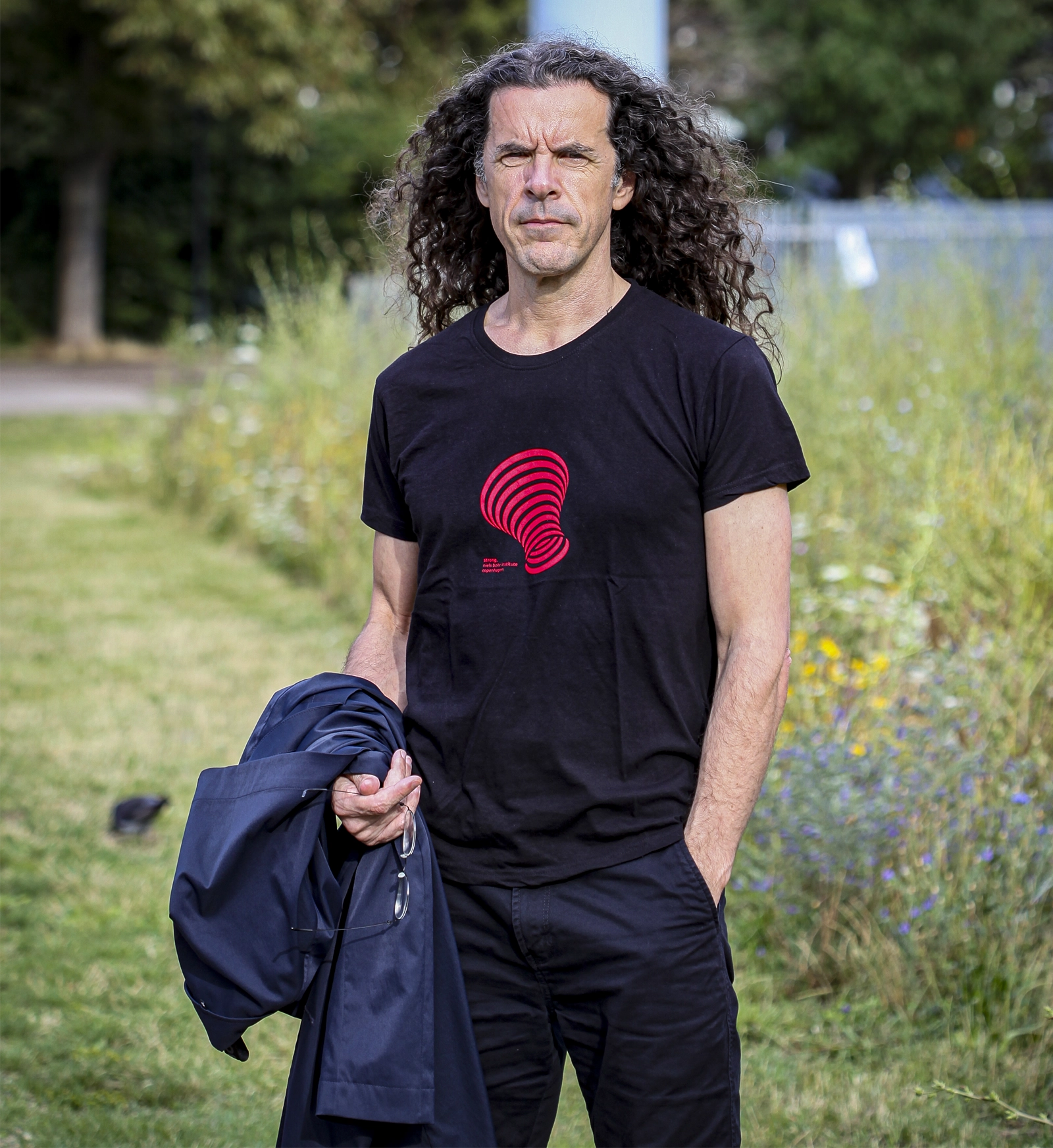
Vitor Cardoso led a recent analysis of black hole collisions that found that any “hair” would have to lie closer to a black hole than 40 kilometers.
Ana Carvalho
So no hair has been seen, for now. But theorists continue to think through a multitude of possibilities, with cracks in Einstein’s theory suggesting that subtle, quantum “hair” ought to exist, even if it might be extremely challenging or even practically impossible to spot.
What Einstein Didn’t Predict
The question of hairy black holes is intimately connected to the greatest puzzle in modern physics: How can general relativity be merged with quantum theory?
Consider the situation where an object crosses a black hole’s point of no return, called the event horizon. According to general relativity, all outsiders will see is how the swallowed object contributes to the two numbers that describe the black hole: how much mass the object adds, and how much faster or slower it makes the black hole rotate.
Yet the disappearance of all other information about the engulfed object conflicts with one of the central tenets of quantum mechanics. Quantum theory requires that all information be preserved and that it remain, in theory, accessible — otherwise quantum probabilities won’t add up to 100%, as they must. Theoretical physicists have long been fascinated by this conflict between the predictions of general relativity and those of quantum mechanics, which is known as the information paradox.

The Virgo interferometer near Pisa, Italy, detected its first gravitational wave signal in 2017.
Virgo Collaboration
In 2012, physicists showed that this paradox is tightly linked to the nature of the event horizon. They’d known since the 1970s that black holes emit radiation, and that this radiation probably somehow carries the scrambled information about the stuff that fell into the hole. Now they imagined what would happen if an astronaut who was about to cross the horizon of an ancient black hole communicated with someone far away — an observer who had gathered the radiation emitted by the black hole over its lifetime. The result of the thought experiment was puzzling: The astronaut and the faraway observer would end up with two copies of the same information, one recovered over the black hole’s long lifetime and the other from close by. The extra copy is a problem, again spoiling the careful accounting of probabilities that quantum mechanics relies on. Some physicists concluded that something strange must happen just outside the horizon to disrupt the astronaut’s information gathering.
Short Hair, Long Hair
Attempts to address the information paradox usually add extra detail outside the event horizon, referred to as quantum hair. The researchers who came up with the thought experiment about the astronauts in 2012 suggested that a shell of extremely high-energy particles called a firewall might lie just outside the horizon, breaking the connection between the two observers. Alternatively, the physicist Samir Mathur argues that black holes don’t have a horizon at all. Instead, he says that they are “fuzzballs” — each one a quantum combination, or superposition, of many different configurations of space-time, making the black hole’s edges fuzzy.
Other ideas include “gravastars” that resemble black holes but are surrounded by shells of exotic matter, and so-called regular black holes — reimagined versions of the objects that lack the infinitely dense points in their centers known as singularities.
This zoo of proposals all introduce new effects outside the horizon that should change how a vibrating black hole emits gravitational waves.
The proposed effects generally lie very close to the horizon, perhaps only within 10−33 centimeters — the so-called Planck length. Such close-cropped quantum hair would not be directly observable as a change in the signals from black hole collisions, but it might be visible in other ways. For example, unusual aftereffects called echoes, generated as gravitational waves bounce off a firewall or other structure near the horizon, might appear after an initial signal.
Searches for echoes have so far come up empty. These failed searches don’t rule out the possibility of quantum hair, however, since it’s unclear which kinds of quantum hair should give rise to echoes and which won’t, or how exactly the echoes would appear.
Meanwhile, physicists can also look for “longer” hair — more obvious deviations from Einstein’s theory. There’s less theoretical reason to expect this, but on the other hand, the highly curved space-times near black holes are a new environment for astronomers, and they can’t be sure what they might find. Perhaps space-time curves differently under these conditions than general relativity predicts.
“I think it’s a worthwhile exercise to go and test that,” said Niayesh Afshordi, an astrophysicist at the University of Waterloo in Canada.
Math Meets Data
Since the first detection of colliding black holes by the Laser Interferometer Gravitational-Wave Observatory, or LIGO, in 2015, physicists have been trying to use this data to test Einstein’s theory. The project accelerated after additional observatories — Virgo in Europe and KAGRA in Japan — came online. But a substantial mathematical challenge stood in the way: The black holes that collide are always rotating, which greatly complicates calculations. The mathematician Roy Kerr calculated back in 1963 how rotating black holes behave in the framework of Einstein’s equations. But what if that framework is wrong?
A group of physicists at KU Leuven cracked the problem in 2023. They developed a technique for understanding how fast-spinning black holes would behave if Einstein’s theory were modified.
Then, at a conference later that year, a graduate student in the Leuven group, Simon Maenaut, met Gregorio Carullo, a postdoctoral researcher in Copenhagen at the time who was an expert in analyzing gravitational wave signals. They realized that they could test the Leuven group’s theories against Carullo’s data, and they wasted no time. “We sort of jumped on a free desk and started coding together,” said Carullo, who is now at the University of Birmingham.
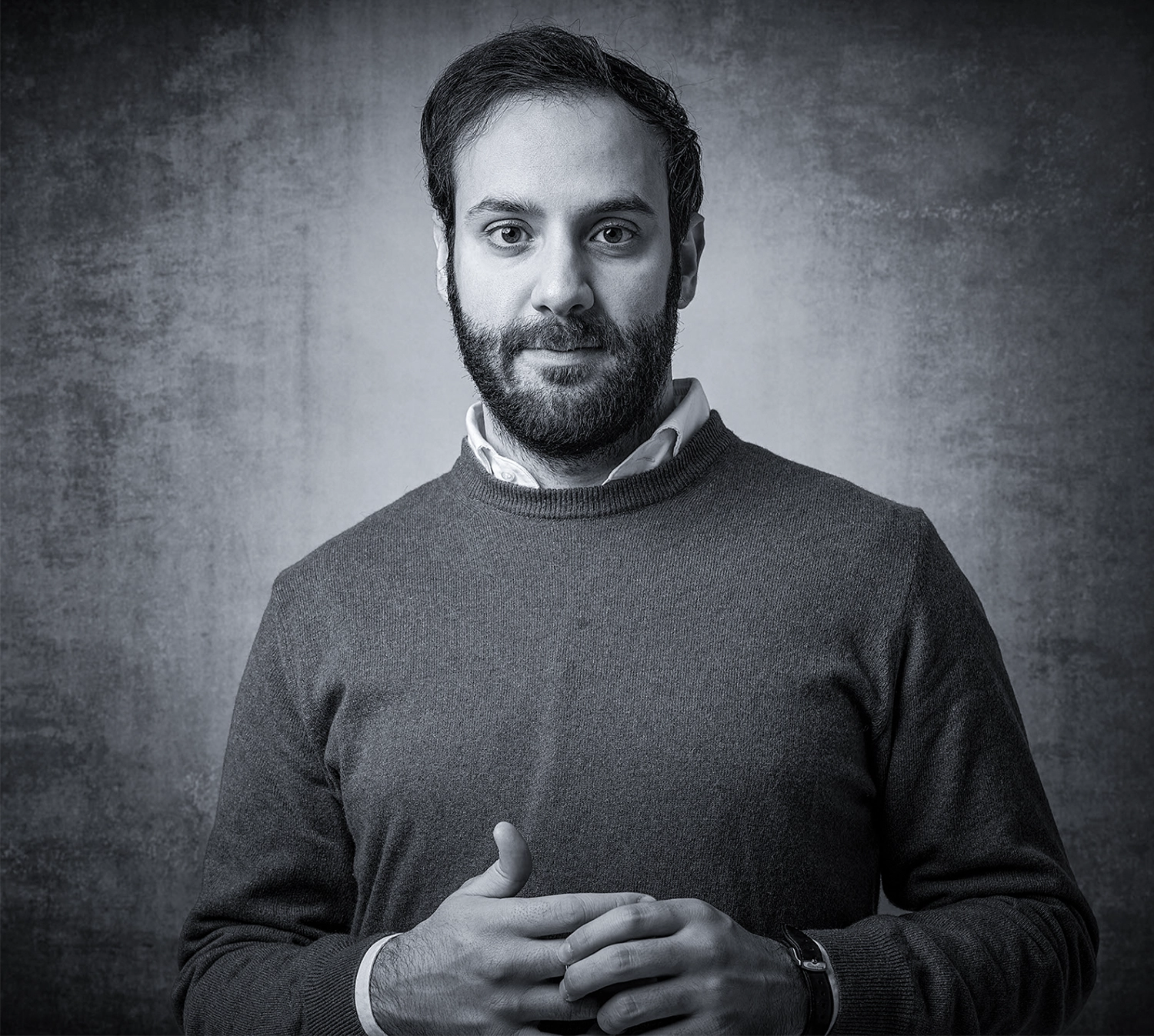
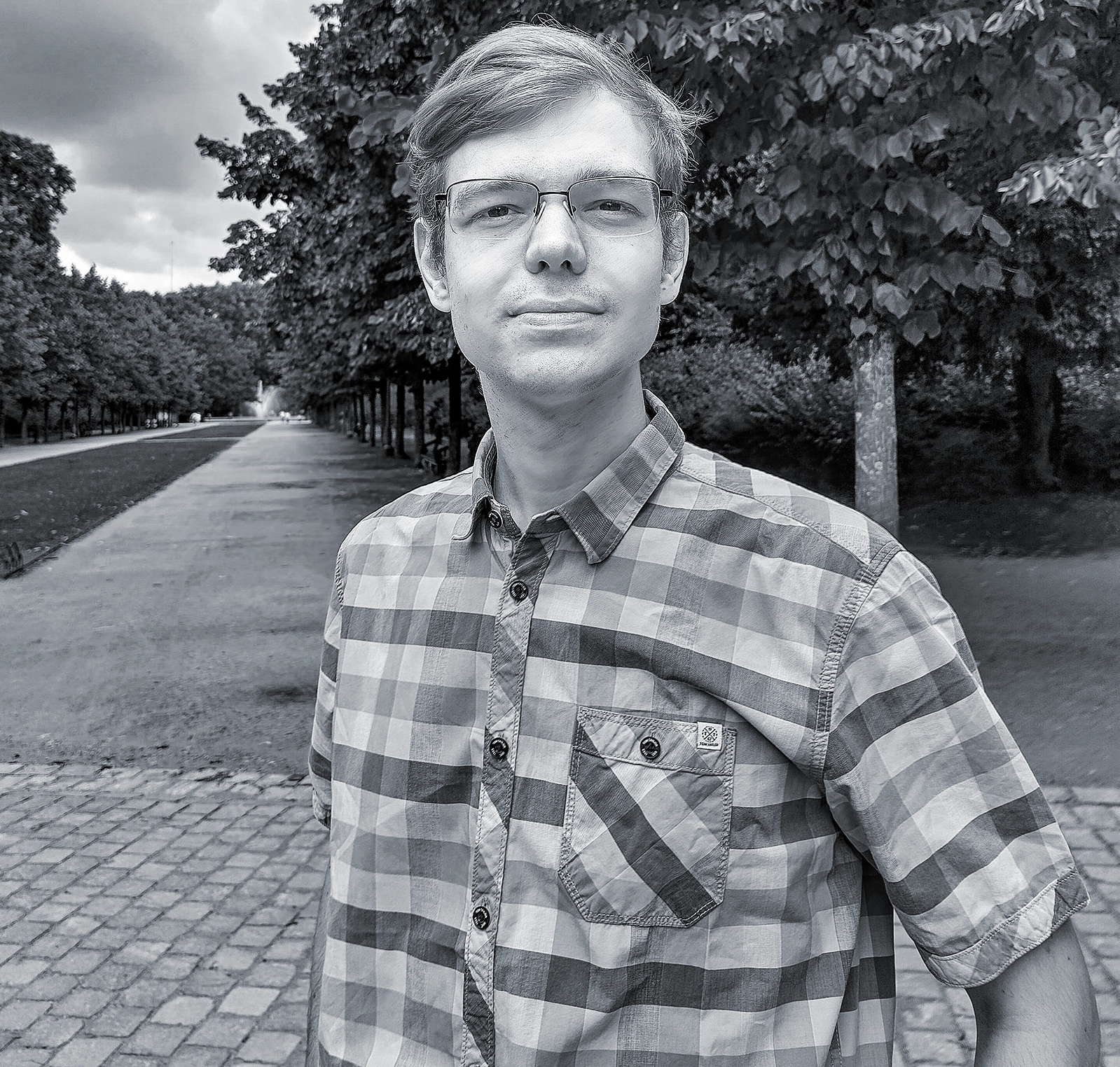
When they met at a conference, Gregorio Carullo (left) and Simon Maenaut realized that they could combine the latter’s analysis techniques with the former’s gravitational wave data to conduct a test of the no-hair conjecture.
Bjarne Sørensen/NBIA; Emilia Maenaut
They combined the data from 22 black hole collisions, determining how the collisions would look if they all came from black holes of the same mass. They then compared this data against predictions from the Leuven group. The approach allowed the researchers to ask: Suppose Einstein’s theory goes wrong for highly curved space-time, and something like a firewall or a fuzzball shows up outside the event horizon. How long could that “hair” be? How close would you have to get before a black hole might behave differently than it would under general relativity?
With 95% confidence, they ruled out any deviations from Einstein’s predictions farther out from the horizon than 40 kilometers. For most of the observed black holes, that’s a bit less than the radius of the black hole itself. The researchers weren’t able to give the black holes a buzz cut by any means, let alone the close shave that most physicists expect would be necessary to test proposed solutions to the information paradox. The result does mean that black holes don’t wildly depart from Einstein’s theory.
On the Horizon
LIGO, Virgo and KAGRA are slated to run for the rest of the decade, if not longer, and will be joined by another observatory in India around 2030. More data will lead to more precise measurements.
Later, next-generation gravitational wave detectors — a planned telescope called Cosmic Explorer in the U.S., and one called the Einstein Telescope in Europe — will enable a jump in precision. “The Einstein Telescope will basically observe all the black holes in the universe of a certain mass range … which is incredible,” Carullo said.
It will then be possible to peer closer. Instead of hair a few dozen kilometers long, researchers will be able to look for violations of Einstein’s theory the length of a football field.
“It’s possible that we will confirm Einstein’s theory of general relativity to five decimal places, and that would be great,” Maenaut said, “but it’s also possible that we come across something that we didn’t expect.”

